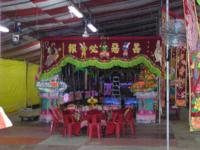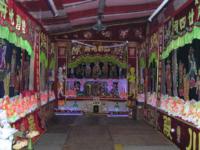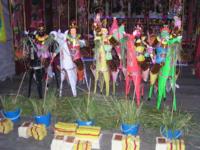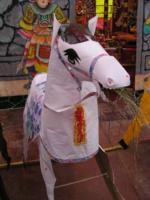| TANKI | | The Ancient Gods, Rituals and Spirit-Mediumship of Folk Taoism in Modern Singapore |
On the birthdays of major deities or gods, larger scale
temple festivals may be held during which the tankis become possessed by the
deities and elaborate self-mutilation rites to demonstrate the power of the
deities.
A huge oblong-shaped tentage would be set up on an open
ground, with elaborate altars installed within. The actual geographic direction of altars aren’t very
important in Singapore. Given the acute land constraints, festival organizers
make do with what they have though relative positions within every festival tent
tend to be fairly similar. I would
use the example of a festival setup at Sago Street, Chinatown, Singapore, in
late 2003 as an illustration.
At the eastern end of the tentage, an altar was set up
dedeicated to the Jade Emperor (Yu Wang Da Di), supreme god of the Taoist world,
and key heavenly gods, with food offerings laid out in front of the statues or
paintings of these gods.
A festival tent, with the altar of the Jade Emperor ahead
At the western end would be an altar to the key patron
deity of the temple together with other heavenly gods and deities.
Statues of deities from other “friendly” temples are often brought to
a festival as guests of honour (- one reason why many temples have two statues
of the same god – one to be at the temple at all times and the other to serve
as “ambassador”), and the mediums of these temples sometimes turn up to be
possessed by their respective “visiting” deities.

Table of feast for the Gods of Hell, at the entrance to the shrine to Hell |

Shrine of Hell |

The Five Heavenly Protector Gods & their Horses |

Horse belonging to a Protector God |
To the north of the western altar is an altar dedicated to
the Protector Gods - “Wu Yin Jiang Jun” (Generals of Five Camps)
– military corps of the Taoist Heaven.
Apart from an equally elaborate altar with statues, paintings and
offerings, one would expect to see paper statues of the horses representing the
Marshals of the North, South, East, West and Central, well fed with pots of
grass on the ground.
The most interesting shrine lies to the south of the
western altar. This is the shrine
of the hell deities – normally a self-contained room of its own, sometimes
extended into a further room within the tentage.
The entrance to the shrine is sometimes shaped like a gateway into hell.
It is normally dark, with gory painting of the Taoist hell.
Images of gods, deities are painted with luminous colours which glow in
the dark, which makes the shrine even more eerie.
Mats and umbrellas are sometimes laid out on the ground – visitors
beware! Do not step onto these for you may just step onto the invisible visitors
from hell!
It is important that the concept of hell for the Taoist world is very different from that of Christianity. The latter regard hell as a dead end, where evildoers are condemned for all eternity. Taoism, however, sees hell as a kind of boot-camp where most people would go through in the almost eternal cycle of birth, life, death and reincarnation. The good guys would pass through the 10 “courts” of hell and its 18 levels with little or no suffering while the evildoers would get their due, such as being burned by fire, boiled in hot water, tongues cut, etc – images of these processes are duly represented in the many paintings hung in the shrine of hell. In addition, the God of Hell, in Taoism, is not evil Saturn, but a mere administrator who have to perform the task of reforming the evildoers.
Buy these books!
 |
 |
 |
| Lonely Planet: Singapore | DK Eyewitness Travel Guides: Singapore (Eyewitness Travel Guides) | Lonely Planet: Malaysia, Singapore, Brunei |
|
Tan Wee Cheng 2004 |